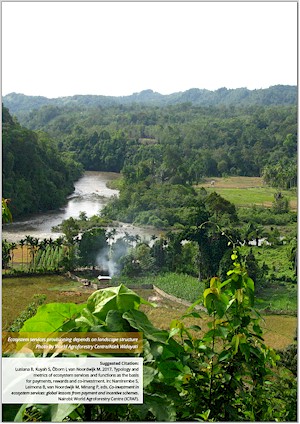| Book Chapter |
 |
|
| Title | Typology and metrics of ecosystem services and functions as the basis for payments, rewards and co-investment | | Author | Betha Lusiana, Shem Kuyah, Ingrid Oborn and Meine van Noordwijk | | Editors | Sara Namirembe, Beria Leimona, Meine van Noordwijk and Peter A Minang | | Year | 2017 | | Book Title | Co-investment in ecosystem services: global lessons from payment and incentive schemes | | Pages | 1-15 | | Call Number | BC00431-17 |
|
| Abstract: |
| To successfully and sustainably develop and implement payment, reward or co-investment schemes for ecosystem services (ES) there is a need to define typologies of ES and to develop and agree on robust metrics to monitor ecosystem services and functions as the basis for quantifying, and translate in monetary terms, the services provided or benefitted. The starting point for the most commonly used classification of ‘ecosystem services’ (MEA1) are the types of benefit humans derive from provisioning, regulating, cultural and supporting services. Provisioning services refer to products obtained from agro- or wild ecosystems, and include agricultural, forestry, animal husbandry, fishery and wildlife management activities; regulating services are benefits obtained from the regulation (reduced variability) of environmental and ecosystem processes such as water infiltration; cultural services are non-material benefits people obtain from ecosystems through spiritual enrichment, recreation and cultural aesthetics, and supporting services relate to ecosystem dynamics necessary to produce any of the other ES for example nutrient cycling and pollination. This classification based on human benefits is a step towards economic valuation of the goods and services provided2. However, at the level of ecosystem structure and function, other ways of grouping can help to understand interactions with land use and the potential synergy in structural interventions at the level of soils, vegetation, flora, fauna or climate. An understanding of ecosystem function in the water, nutrient and carbon balances, the life histories and population dynamics of its component species, and the wider biodiversity patterns; can connect ecosystem structure, through functions to human benefits |
|